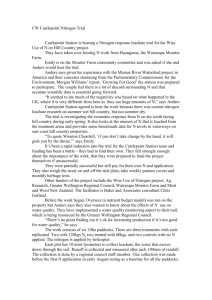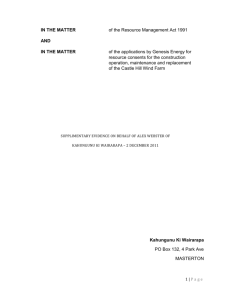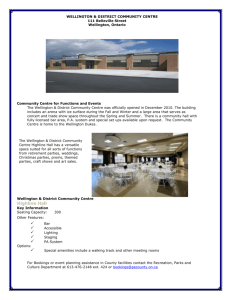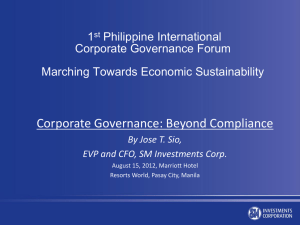Wellington City ( 331kb)
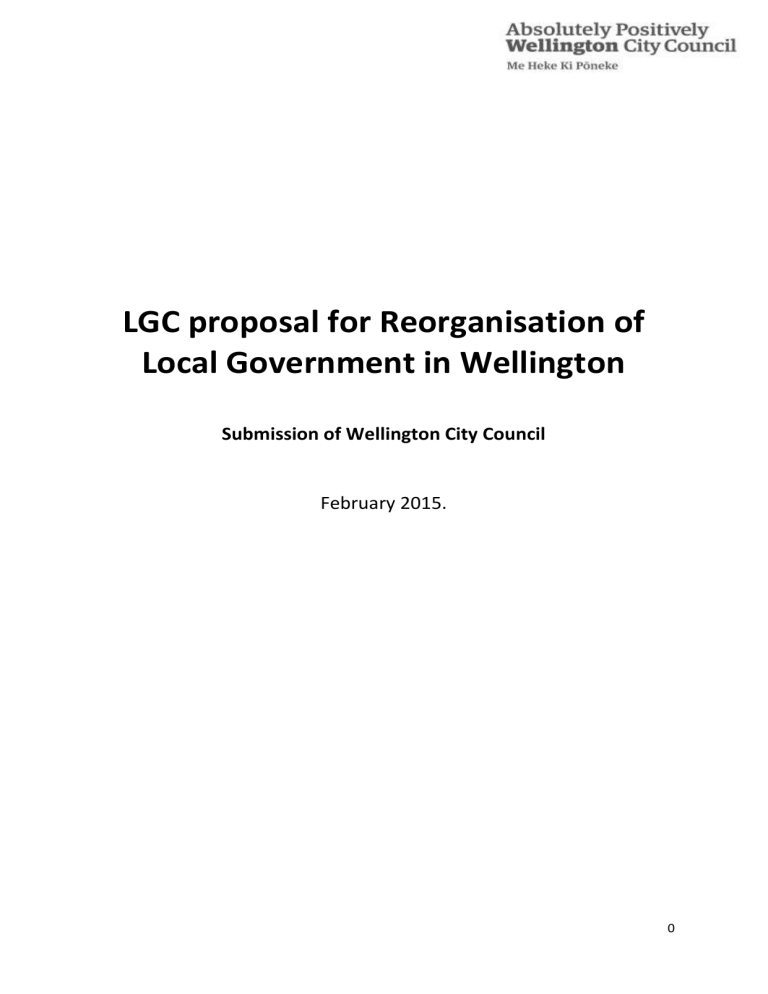
LGC proposal for Reorganisation of
Local Government in Wellington
Submission of Wellington City Council
February 2015.
0
Introduction
1.
This submission responds to the Commission’s request for feedback on the proposed
2.
Thank you for the opportunity to provide comment. We wish to be heard in support of this written submission and contact details can be found at the end of the submission. reorganisation of local government in the Wellington region.
Overview of public opinion
3.
The submission points in this submission are based on:
region wide consultation carried out by the Joint Working Party in 2013
research carried in 2013 by Litmus and Colmar Brunton
research carried out by Nielsen in February 2015 to understand the community’s views on the Commission’s proposed model. The Nielsen survey was regional
(covering the affected areas) and is based on large and robust sample size of 1,000 participants. The overall margin of error is +/- 3.1 percent.
4.
Research and consultation results have remained broadly consistent since 2013. The community agrees that the ‘drivers for change’ are important, but the proposed governance model designed to deliver on them lacks broad support. The 2015 Nielsen survey shows that:
support across the region for the Commission’s proposal is very weak at just 26 percent
support for the Commission’s proposal is weakest in the Wairarapa (17 percent) and the Hutt Valley (18 percent)
Support for the Commission’s proposal is slightly higher in Porirua and Kapiti (29 percent) and Wellington (30 percent).
5.
The threshold in a referendum to secure change is 50 percent +1 across all affected areas.
Summary of our position
6.
There is a case for change. The community wants to see improvements from councils in the region, but they don’t support the model that is being proposed. We believe the lack of broad community support is due to the limitations of the model.
1
7.
The limitations are that it
combines a number of separate communities of interest, it is one of the least efficient models that the Commission considered practicable, there are serious questions in relation to how effective the ‘shared governance’ model actually is, and with its two tiers structure, the model blurs access to, and accountability of elected members.
8.
While we support the use of a referendum to determine change, we believe it would be a waste of resources to hold a referendum on the current proposal because the result will be clearly negative. There are solutions and alternatives available to the Commission, but the model either needs to have significant changes made, or ideally be replaced by a new model that has broader community support.
The best alternative model to the status quo is not currently in front of the community
9.
Periodically reviewing governance and service delivery arrangements is part of any strong and healthy democracy. The current review process provides a once-in-a-generation opportunity to put into place a structure that meets community aspirations now and in the future, improve service delivery and allows the region to grow and prosper.
10.
The ‘desire for change’ is certainly real – research and consultation results all point towards a broad community desire for the local councils in this region to perform better on a number of fronts, including: 1
Regional leadership
Economic development
Simplified planning
Integrated infrastructure delivery
Better service delivery 2 .
11.
The Commission has stated that its proposal is designed to deliver on these desired improvements, but research shows that it lacks broad community support. The research shows that if a referendum was held:
26% would support the Commission’s proposal
61% would oppose the Commission’s proposal
14% are undecided.
1 85% of the region’s population believe the drivers for change are important (2013 consultation results on
Joint Working Party models)
2 We note that since 2013, governance of economic development, three waters and IT services have taken strides forward in cooperation accross the region. We also note that Wellington’s GDP per capita is considerably higher than either Auckland or the national average, and it continues grow at a similar rate.
2
12.
Considering the community has expressed a clear desire for improvements from the local councils in the Wellington region, yet support for the proposal is low, we have to question whether the best alternative to the status quo has been presented to the community for consultation.
13.
We believe the proposed model has significant limitations and that this is affecting the level of support the model is receiving in the community. The Commission needs to focus on shaping a model that can deliver the desired improvements and is achievable in the
Wellington context, because the current proposal, as presented, is a missed opportunity.
14.
The scope of this submission is based around exactly that point. It does not seek to exhaustively comment on all aspects relating to the proposal and focuses simply on the limitations of the proposed model and on identifying a way forward.
A way forward
15.
While we acknowledge that the Commission is constrained by legislation in what it can propose we believe the best alternative to the status quo must be based on the following criteria:
the model is able to win broad community support
the model represents an easily identifiable community of interest that is recognised and accepted by those that are affected
the model is demonstrable more efficient and effective than the current model
the model provides for the community to have direct access to, and accountability from their decision-makers.
16.
We don’t believe the proposed model achieves those criteria to any satisfactory level:
It hasn’t won broad community support
it includes a number of separate communities of interest that oppose this form of amalgamation
it is one of the least efficient models that the Commission considered
there is no certainty that the local decision-making level proposed by the
Commission will be endorsed by a future council in the spirit sought by the
Commission
it blurs accountability of elected members.
17.
Our preferred alternative to the status quo is one or more single tier unitary authorities.
We believe it has the ability to achieve the above criteria to a greater degree. It is significantly more efficient, members of the community will know who to approach to raise an issue, accountability of elected members is clear, and threcognises clear distinct communities of interest.
3
18.
Our research also shows that an alternative model that provides for a separate Wairarapa and with one or more councils West of the Rimutakas would win significantly more community support than the current proposal out for consultation.
26% would vote in favour of the commission’s proposal
50% would vote in favour of the alternative.
19.
We note that under legislation that the Commission needs to be satisfied that it has demonstrable support in each affected area before issuing a final proposal, and since it doesn’t, we recommend the Commission reconsiders its current proposal and considers and consults on an alternative which has a separate Wairarapa Council and one or more metropolitan Councils which may or may not be unitary entities.
4
Limitations of the proposed model
LOCAL DEMOCRACY
Division of responsibility is not set in stone
20.
The Commission’s draft proposal sets out a shared governance structure where local boards make local decisions and the council makes regional decisions.
21.
The Commission has made a recommendation that local boards have significant responsibility over local matters and discussions over the division of responsibility in terms of decision-making have been suggested as circa 70 percent regional, and 30 percent local 3 .
22.
This is only a recommendation though. Ultimately it will be up to the new Council to determine the responsibilities and budgets of local boards.
23.
In short, while the Commission has advocated for a strong role by local boards and some guidance is provided in legislation, there is no guarantee that this will eventuate.
24.
Regardless of where any new council determines the division of responsibility, local boards are restricted under legislation from holding key governance responsibilities including:
making a rate
setting bylaws
making district plans
borrowing money
purchasing or disposing of assets.
Local Boards are costly and cumbersome
25.
Having local boards adds cost. The additional costs have been proven in Auckland to be in excess of $1m per board per year, but the hidden costs are not quantified in that figure, and consequently the figure is expected to be significantly higher.
26.
These include the time spent discussing matters between the governing bodies, the additional administration costs to operate local boards, as well as the costs associated with
3
The Joint Working Party (comprising Wellington City Council, Greater Wellington, Porirua City Council and Kapiti District
Council) conducted analysis based on the operations of Auckland and concluded a division of 95 percent regional /5 percent currently existed there.
5
negotiating budgets and levels of service between the council and the local boards. Given local board’s inability to obtain its funding directly, the negotiations and associated costs will be significant.
27.
Local boards will add at least an additional $8 million to the rates bill, and it is very likely to be significantly more in comparison to the alternative direct access metropolitan model advocated by the Wellington City Council.
28.
The Commissions own findings (page 216 of volume 2) demonstrate that the proposed model is the least efficient model of all the practicable options looked at.
29.
Considering the purpose of local government legislation clearly requires councils to be as efficient as possible, it is unclear how the proposal best meets the legislative test of delivering services “in a way that is most cost effective for households and businesses”.
Local Boards do not enhance local democracy
30.
The Commission’s proposal of shared governance does not enhance local democracy. Since the final division of responsibility is determined by any future new council, and local boards have to negotiate budgets for their local plans, their powers can be best described as
‘powers of petition’.
31.
We do not believe that access to elected representatives that have limited influence over decision-making enhances meaningful representation.
32.
Shared governance also makes it difficult for the community to determine who they should approach to have a matter resolved, and it also blurs accountability. Any governance structure that allows elected members to obfuscate responsibility for decisions or inaction is flawed.
33.
The community has also shown a clear preference for dealing with councillors over local board members. Our research asked participants who they preferred to approach to resolve an issue, and:
49% of respondents prefer to approach a locally elected councillor
18% prefer to approach a member of a local board
17% had no preference.
34.
The shared governance arrangements can also result in tension between the two tiers of representation. This was demonstrated recently in Auckland where funding for local board plans was reduced to minimise the rates increase.
6
35.
We believe meaningful access to elected members that have influence at the top table is far more desirable. Research shows that the community agrees. A single tier of representation with small single member wards can achieve this far more effectively.
36.
Such a model still allows for community boards to be formed around communities of interest that can demonstrate a desire for them, rather than having local boards being assigned by the Commission.
Local democracy – recommendations
That the Commission give consideration to developing a single tier governance structure to ensure direct access to, and direct accountability of decision-makers.
That elected members be elected from small single member wards and that each ward has an office and administrative support to enhance local democracy and facilitate elected member engagement with their constituents.
7
COMMUNITIES OF INTEREST
37.
We know that residents in the Wairarapa strongly support the formation of a single
Wairarapa – this view is also supported by the rest of the region.
38.
Our research also shows that over two thirds (65 percent) of people in the region see the
Wairarapa as separate to the rest of Wellington.
39.
But the Commission has determined that a single Council stretching from Makara to
Masterton is the most practicable option and best meets the legislative test of ‘good governance’.
40.
41.
At its simplest this is based on three main assertions:
the Wairarapa and the region West of the Rimutakas are interdependent
the Wairarapa does not have the resources to effectively deliver all its functions and services by itself, now or into the future
some services cross the Rimutakas and it would be too difficult to de-couple them or find alternative shared governance and delivery platforms.
We believe the analysis to support these assumptions is limited, raises some questions and avoids alternative solutions that are practical and workable.
Wairarapa’s interdependence with the rest of the region is overstated
42.
43.
44.
45.
The Commission’s report outlines a range of interdependencies between the Wairarapa and the rest of the region based on travel movements, spending patterns, local and central government services and economic connections.
While there is plenty of analysis on things ‘we have in common’, little analysis is done on differences. The reality is that one area is predominantly urban, and the other rural. That means they have different economies, different issues to resolve and different ways of life.
The report also examines interdependencies without using adequate counterfactual scenarios. The Horowhenua district, neighbouring the Wellington region shares many characteristics with the Wairarapa (being a rural hinterland with economic links to
Wellington City and the rest of the region), and as such, makes sense to use as a comparator to the Wairarapa, but is only used in one simple metric (journey to work).
Most critically, economic interdependency between the Horowhenua and the region are not considered. This analysis would, in our opinion, highlight that the economic interdependencies between the Wairarapa and the rest of the region are not likely to be significantly greater than that of Horowhenua.
8
46.
In this case, using these interdependencies as a justification for including Wairarapa in the defined community of interest is based on incomplete analysis. While this point is somewhat technical in nature, it is critical to the report – the analysis of the Wairarapa as being part of the Regional community of interest shaped the subsequent thinking on the report and the final proposed model.
Wairarapa’s inability to be financially viable on its own is overstated
47.
48.
49.
50.
The Commission has determined that the Wairarapa is not financially viable on its own.
This is based on the view that the Wairarapa has some of the highest rates in the region and that the impact of the funding shortfall would negatively impact on rates to a level where it was not sustainable long-term on its own 4 .
Several numbers have been generated for the shortfall ranging from $2m to $11m pa with the Commission accepting the higher figure. The Joint Working Party supported by professionals with significant sector experience confirmed a figure midway between those two of $7.9m, and this was confirmed by PWC, and agreed by the Working Party.
Firstly, the funding shortfall equates to 0.2 to 1.1% of the region’s annual operating expenditure, and we question the appropriateness of using regional reform for what is in the bigger scheme of things a very small financial issue.
Secondly, we have serious questions about how the Commission has come to the position that it considers the Wairarapa to have some of the highest rates in the region.
51.
The Commission has used a rates per resident calculation, and because the Wairarapa has
15 percent absentee landlords (due to holiday houses), this artificially inflates the rates position for that region.
52.
53.
The average residential rate is actually very similar in the region, and South Wairarapa in particular, has some of the lowest rates in the region.
In short, we question the appropriateness of the Commissions use of the highest possible shortfall (that remains disputed by the Wairarapa) and a rates per resident calculation to determine the viability of the Wairarapa as a separate authority.
4 The shortfall arises from an existing subsidy that occurs from the way the Regional Council sets its rates.
9
Is the principle of cross subsidisation even appropriate?
54.
55.
56.
57.
58.
It has been interesting as part of this process to observe the amount of regional ratepayers money that has been flowing from ratepayers on the West of the Rimutakas to those in the
Wairarapa.
This is, in effect, cross subsidisation from one community to the next. If we are to structurally entrench this type of ‘rural welfare’, it sets a precedent that could be repeated elsewhere. The Wairarapa does not seek it, nor desire it.
Using similar justifications such as economic interdependencies and property ownership, similar arrangements could easily be argued for in areas like Kaipara (with respect to its relationship with Auckland).
Indeed, large amounts of provincial New Zealand are experiencing decline and would likely benefit by being amalgamated into an area incorporating a large metropolitan area, but the benefits of this to NZ Inc. and our cities are dubious at best.
Local Government New Zealand is forecasting that circa 40 percent of local authorities will experience declining populations by 2031. This is a significant issue and something that requires careful consideration and a full exploration of all the options.
59.
Local Government New Zealand is actively undertaking this work with government and it would be prudent to wait for the results of this work rather than entrenching ‘rural welfare’ in any new structure for the Wellington region.
60.
It is important to note that the Wairarapa is not experiencing a population decline overall, and it is clear from their own application to the Commission that they believe they have the necessary resources to be viable as a separate council.
61.
We don’t believe a reorganisation scheme is the most appropriate way to resolve the
Wairarapa shortfall issue. They have a wide range of options to resolve the shortfall including increasing rates, adopting ‘right size’ approach to their levels of services, adopting strategies to grow the size of their rating base, as well making efficiencies.
10
Communities of interest – recommendations
We recommend that the Commission give greater consideration to alternative governance arrangements for the region that provides for one or more authorities recognising that each is a distinct community of interest.
We note that there already exists a precedent for joint CCOs, the sharing of expertise between councils, and the transfer of responsibility in the region and recommend that these be considered as part of any governance model
11
CONCLUSION
62.
63.
64.
65.
After considerable discussion in the region on the question of amalgamation – the region is in a situation where there is broad agreement that there is a ‘case for some change’, but the proposed model that has been designed to deliver it, lacks broad appeal and would very likely fail in a referendum. This is a missed opportunity.
We strongly believe that this is because the proposed model has significant limitations. In particular, it includes a number of communities of interest that strongly wish to remain independent and the shared governance arrangements of the model have not won broad appeal.
We firmly believe the best alternative to the status quo is not currently in front of the community for consideration.
Under legislation, the Commission can only issue a final proposal if it is ‘satisfied’ that it has
‘demonstrable’ support in each of the affected areas. Survey results clearly show that demonstrable support is lacking in key areas, and while we are strongly in favour of any reorganisation scheme ultimately being decided by a binding referendum, we question whether holding a referendum on the current proposal is wise considering the result will be clearly negative.
Recommendations
That the Commission reconsiders its current proposal and considers and consults on an alternative which has a separate Wairarapa Council and one or more metropolitan Councils which may or may not be unitary entities.
Contact details:
Baz Kaufman – Manager Strategy and Research
Baz.kaufman@wcc.govt.nz
021 2478724
12
